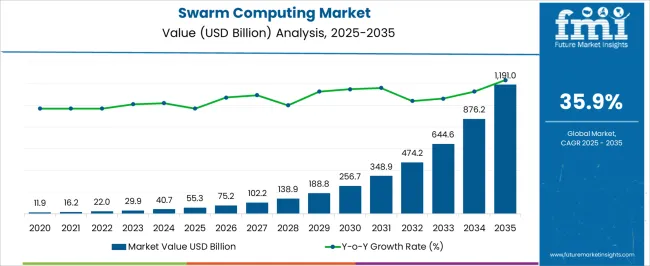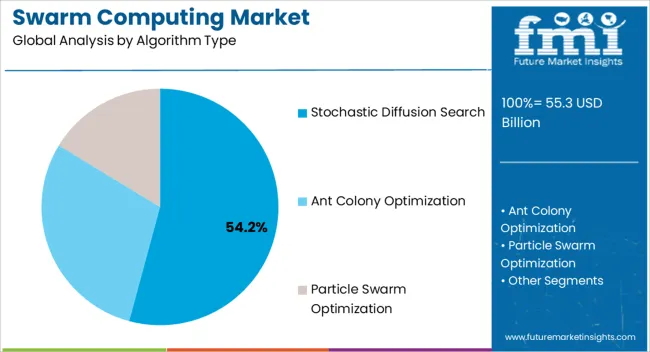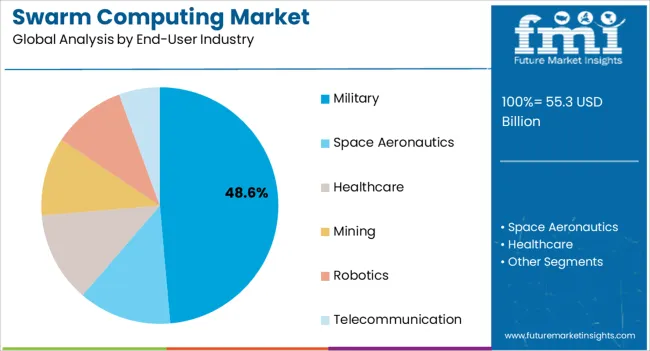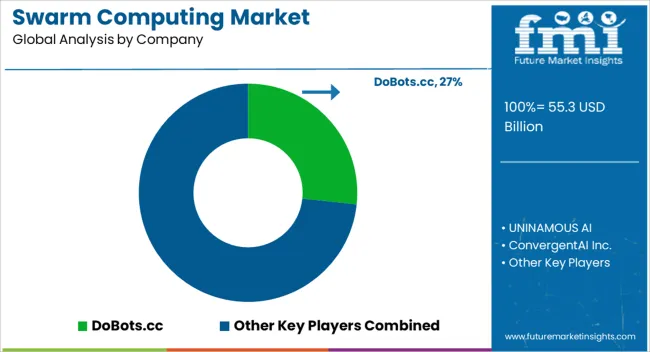The Swarm Computing Market is estimated to be valued at USD 55.3 billion in 2025 and is projected to reach USD 1191.0 billion by 2035, registering a compound annual growth rate (CAGR) of 35.9% over the forecast period.

| Metric | Value |
|---|---|
| Swarm Computing Market Estimated Value in (2025 E) | USD 55.3 billion |
| Swarm Computing Market Forecast Value in (2035 F) | USD 1191.0 billion |
| Forecast CAGR (2025 to 2035) | 35.9% |
The swarm computing market is experiencing strong growth as industries adopt decentralized and nature inspired algorithms to address complex optimization and resource management challenges. Rising data volumes, coupled with the need for adaptive and scalable computing, have accelerated the integration of swarm based systems across defense, logistics, and industrial applications.
Advancements in artificial intelligence, distributed ledger technology, and autonomous systems have further supported the deployment of swarm computing models capable of dynamic decision making in real time. Increased government and private sector investments in military and security research have created new opportunities for the use of swarm intelligence in mission critical environments.
The future outlook remains favorable as enterprises and defense organizations seek robust, efficient, and fault tolerant computing methods to handle evolving operational complexities.

The stochastic diffusion search algorithm type segment is expected to account for 54.20% of total market revenue by 2025, establishing it as the leading segment. This growth is driven by its efficiency in handling large scale optimization tasks and its robustness against noisy or incomplete data.
The algorithm’s decentralized nature allows tasks to be distributed effectively across multiple agents, reducing computational complexity and improving scalability. Its adaptability in dynamic environments has strengthened adoption in applications requiring real time decision making and resource allocation.
With its proven capability to deliver reliable results in uncertain conditions, the stochastic diffusion search segment continues to dominate the algorithm type category.

The military segment is projected to represent 48.60% of overall market revenue by 2025, making it the leading end user industry. This is attributed to the growing reliance on swarm intelligence for surveillance, reconnaissance, and autonomous combat systems.
Military operations require robust, scalable, and adaptive solutions, all of which are effectively supported by swarm computing models. The ability to deploy large groups of autonomous agents that can self coordinate without central control has proven valuable in defense applications.
Additionally, investments in next generation warfare technologies and strategic security initiatives have further propelled demand. As global defense agencies prioritize innovation and rapid response capabilities, the military segment maintains its leadership in driving adoption within the swarm computing market.
| Attributes | Details |
|---|---|
| Automation | Swarm computing provides automation for providing logical analysis of the most complex algorithms related to Artificial Intelligence and Machine Learning. This leads to the adoption of the Just In Time (JIT) approach, which is a crucial parameter for any kind of Operations Management. |
| Improved Decision Making | Swarm computing considers different kinds of samples. After that, the analysis is carried out through an algorithm, which ensures all the processes are carried out based on the set standards. This is well expected to increase the swarm computing market share, as it makes use of the ‘Brain of Brains’. |
| Military Services | The swarm computing is used in military drones. This is done to find the target and schedule the required object toward the target with precision. |
| Treatment of Tumors | Another breakthrough application of swarm computing is that it is used for killing cancerous tumors. This is done by employing nanobots in the body which work on the swarm computing principle. |
| Data Mining | Data mining involves analyzing and doing research based on the available data. Swarm computing performs effectively in data mining as well. This as well is expected to increase the demand for swarm computing. |
| Attributes | Details |
|---|---|
| Still in Development Phase | Despite several benefits offered by swarm computing, this application is still evolving. This might question the ambiguity of the process. |
| Lack of Knowledge | Swarm computing makes use of some of the most advanced applications like Big data analysis, Machine Learning, etc. There are not much-skilled professionals throughout the world who may make the best of these applications. |
Swarm computing makes use of some of the most advanced applications like Big Data analysis, Machine Learning, etc. There are not much-skilled professionals throughout the world who may make the best of these applications.
The global swarm computing industry size developed at a CAGR of 35.5% from 2020 to 2025. In 2020, the global market size stood at USD 6,422.3 million. In the following years, the market witnessed remarkable growth, accounting for USD 21,500.1 million in 2025.
The demand for swarm computing has increased dramatically with the expansion of IoT devices. As more devices are linked, swarm computing offers a method for quickly processing and analyzing the enormous volumes of data produced by IoT devices. By enabling advanced analytics and real-time decision-making at the network's edge, it minimizes the need for centralized processing.
Swarm computing continues to find applications in a variety of fields, including healthcare, robotics, agriculture, logistics, and more. For instance, swarm algorithms assist with fleet management, traffic control, and route planning in logistics and transportation. Swarm robots in agriculture are capable of assisting with jobs like crop monitoring, precise farming, and autonomous harvesting. Swarm computing demand is anticipated to keep expanding due to its adaptability in solving complicated issues across a variety of sectors.
| Historical CAGR (2020 to 2025) | 35.5% |
|---|---|
| Forecasted CAGR (2025 to 2035) | 37.6% |
According to Future Market Insights, the Stochastic Diffusion Search (SDS) segment is predicted to advance at a colossal CAGR of 39.8% during the forecast period.
Application areas for SDS include but are not limited to, pattern detection in data mining, resource allocation in telecommunications, optimization of sensor networks, and logistic optimization issues. Its growth in the worldwide swarm computing industry is largely due to its adaptability and efficacy in a multitude of domains.
SDS has advanced and improved largely due to ongoing research and development projects on swarm intelligence and optimization techniques. The algorithm's position in the swarm computing industry is further strengthened by researchers' ongoing exploration of innovative versions, enhancements, and applications.
According to Future Market Insights, the robotics segment by end-user industry is projected to thrive at a striking CAGR of 20.5% from 2025 to 2035.
Swarm robots are capable of enhancing productivity and performance in a variety of environments. For instance, a swarm of robots in an automated warehouse may team up cooperatively to maximize order fulfillment, inventory control, and material handling. Swarm robots are capable of working together to complete tasks in agriculture including crop monitoring, pollination, and targeted spraying.
Swarm robots' dispersed organization and collective intelligence lead to increased output and resource efficiency. The robotics end-user industry segment has grown by developments in robotics technology, such as miniaturization, sensor capabilities, communication systems, and power efficiency. These developments have made the deployment of swarms of robots more feasible and economical, enabling their incorporation across a variety of sectors and applications.
| Region | Detail |
|---|---|
| North America | The North American swarm computing industry is anticipated to capture a 28.3% share during the forecast period, and it is expected to emerge as a dominant market for swarm computing. Increased investments in drones by the military, rapidly growing Robotics and Artificial Intelligence market in the region are expected to drive the market. Moreover, the availability of skilled professionals and rapid technological advancements in this region makes North America currently one of the leading markets for swarm computing. |
| Europe | The European swarm computing industry is projected to occupy 23.1% shares during the forecast period. Increased usage for automation purposes and the ability of this application to kill cancerous tumors is expected to drive the demand for this market. Moreover, the healthcare sector is growing by leaps and bounds in this region, which further ensures an anticipated increase in the swarm computing market valuation. Additionally, several sectors are making use of data mining, which might further drive the market. |
| Asia Pacific | Asia Pacific currently holds a huge market share, and if the analysts are to be believed, Asia-Pacific might very well become the leading market for swarm computing. Rapid urbanization, fast penetration of the internet, the surge in digitization, and rapid advances in technology are set to be the driving factors. In this region, India and China are the two nations responsible for this surge. With increasing usage of AI becoming common in this region, and robotics as well gaining momentum, the adoption of swarm computing is anticipated to surge in the region. |
| Countries | Forecasted CAGR (2025 to 2035) |
|---|---|
| United States | 18.1% |
| United Kingdom | 34.5% |
| China | 40.2% |
| Japan | 4.9% |
| India | 32.2% |
With various industries realizing the importance of swarm intelligence in decision-making, the start-up network of the swarm computing sector is looking for ways to integrate swarm computing with various other untapped applications.
Some of the start-ups are Swarm Engineering, Cubbit, Brainalysed, Agilox, and Reach Labs.
| Name | Swarm Engineering |
|---|---|
| Year of Establishment | 2020 |
| Service Offered | Process Optimization |
| Description | The machine learning algorithm developed by this startup is used for solving combinatorial problems, like demand, load, or production planning |
| Name | Cubbit |
|---|---|
| Year of Establishment | 2020 |
| Service Offered | Cloud Storage |
| Description | The solution adopted by this start-up uses swarm computing for speed and accuracy, with each cell acting like a node in swarm. The peer-to-peer network of these cells enables secured, sustainable, and collaborative storage. |
| Name | Brainalyzed |
|---|---|
| Year of Establishment | 2020 |
| Service Offered | Financial Forecasting |
| Description | This Start-up provides an AI platform for swarm intelligence. The solution enables scaling profits and predicting market movements. The startup’s platform combines artificial swarm intelligence with data analytics to improve decision-making. |
| Name | AGRILOX |
|---|---|
| Year of Establishment | 2020 |
| Service Offered | Long-range Wireless |
| Description | The start-up makes use of swarm computing to develop Automated Guided Vehicles (AGV). The vehicles communicate with one another without any external control. The vehicles are also capable of retooling themselves. |
| Name | Reach Labs |
|---|---|
| Year of Establishment | 2014 |
| Service Offered | Intralogistics |
| Description | The algorithm has been exclusively developed by this start-up. These offer swarm intelligence solutions for large, power-intensive instruments. |

The key market players are roping in swarm computing in the metaverse to make decision-making more accurate. Moreover, implementing swarm computing in the metaverse will ease forecasts, evaluations, assessments, and prioritizations for these companies.
The key players are DoBot.cc, UNANIMOUS AI, ConvergentAI, Inc., SSI Schäfer Ltd., Valutico, Sentien Robotics, Unbox Robotics, Aquarela advanced, Axon AI, and Avidbots.
| Company Name | SSI Schäfer Ltd. |
|---|---|
| Year and Month | July 2025 |
| Recent Development | SSI Schäfer Ltd and Fraunhofer IML established an enterprise lab. The lab mainly focuses on innovations for the future of logistics. |
| Company Name | Axon AI |
|---|---|
| Year and Month | June 2025 |
| Recent Development | Axon launched Simulator Training, which is the next piece of the company’s VR training platform. This enables the officers to sharpen their skills whenever and wherever on wireless VR headsets. |
| Company Name | Avidbots |
|---|---|
| Year and Month | July 2025 |
| Recent Development | Avidbots and Maplesoft announced their collaboration to bring more innovation to autonomous cleaning robots designed for commercial customers. |
| Attribute | Details |
|---|---|
| Forecast Period | 2025 to 2035 |
| Historical Data Available for | 2020 to 2025 |
| Market Analysis | USD Million for Value |
| Key Regions Covered | North America; Latin America; Europe; Asia Pacific; Middle East & Africa (MEA) |
| Key Countries Covered | United States, Canada, Germany, United Kingdom, Nordic, Russia, BENELUX, Poland, France, Spain, Italy, Czech Republic, Hungary, Rest of EMEAI, Brazil, Peru, Argentina, Mexico, South Africa, Northern Africa, GCC Countries, China, Japan, South Korea, India, ASEAN, Thailand, Malaysia, Indonesia, Australia, New Zealand, Others |
| Key Segments Covered | Algorithm Type, End-user Industry, Region |
| Report Coverage | Market Forecast, Company Share Analysis, Competition Intelligence, Trend Analysis, Market Dynamics and Challenges, and Strategic Growth Initiatives |
The global swarm computing market is estimated to be valued at USD 55.3 billion in 2025.
The market size for the swarm computing market is projected to reach USD 1,191.0 billion by 2035.
The swarm computing market is expected to grow at a 35.9% CAGR between 2025 and 2035.
The key product types in swarm computing market are stochastic diffusion search, ant colony optimization and particle swarm optimization.
In terms of end-user industry, military segment to command 48.6% share in the swarm computing market in 2025.






Full Research Suite comprises of:
Market outlook & trends analysis
Interviews & case studies
Strategic recommendations
Vendor profiles & capabilities analysis
5-year forecasts
8 regions and 60+ country-level data splits
Market segment data splits
12 months of continuous data updates
DELIVERED AS:
PDF EXCEL ONLINE
Fog Computing Market
Brain Computing Interfaces Market Size and Share Forecast Outlook 2025 to 2035
Cloud Computing Market Size and Share Forecast Outlook 2025 to 2035
Visual Computing Market Size and Share Forecast Outlook 2025 to 2035
Mobile Computing Devices Market Insights – Growth & Forecast 2023-2033
Spatial Computing Market Size and Share Forecast Outlook 2025 to 2035
Quantum Computing Market Growth – Trends & Forecast 2025 to 2035
Wearable Computing Market Trends – Growth & Forecast 2025 to 2035
Wearable Computing Devices Market Analysis - Size, Share & Forecast 2025 to 2035
Affective Computing Market Size and Share Forecast Outlook 2025 to 2035
Cognitive Computing Market Size and Share Forecast Outlook 2025 to 2035
Pervasive Computing Technology Market Size and Share Forecast Outlook 2025 to 2035
Server Less Computing Market Size and Share Forecast Outlook 2025 to 2035
Confidential Computing Market Size and Share Forecast Outlook 2025 to 2035
Space On Board Computing Platform Market Size and Share Forecast Outlook 2025 to 2035
Virtual Client Computing Market Size and Share Forecast Outlook 2025 to 2035
Next Generation Computing Market Size and Share Forecast Outlook 2025 to 2035
High-Performance Computing Market Size and Share Forecast Outlook 2025 to 2035
Multi-Access Edge Computing Market Size and Share Forecast Outlook 2025 to 2035
Automotive Quantum Computing Market Size and Share Forecast Outlook 2025 to 2035

Thank you!
You will receive an email from our Business Development Manager. Please be sure to check your SPAM/JUNK folder too.
Chat With
MaRIA